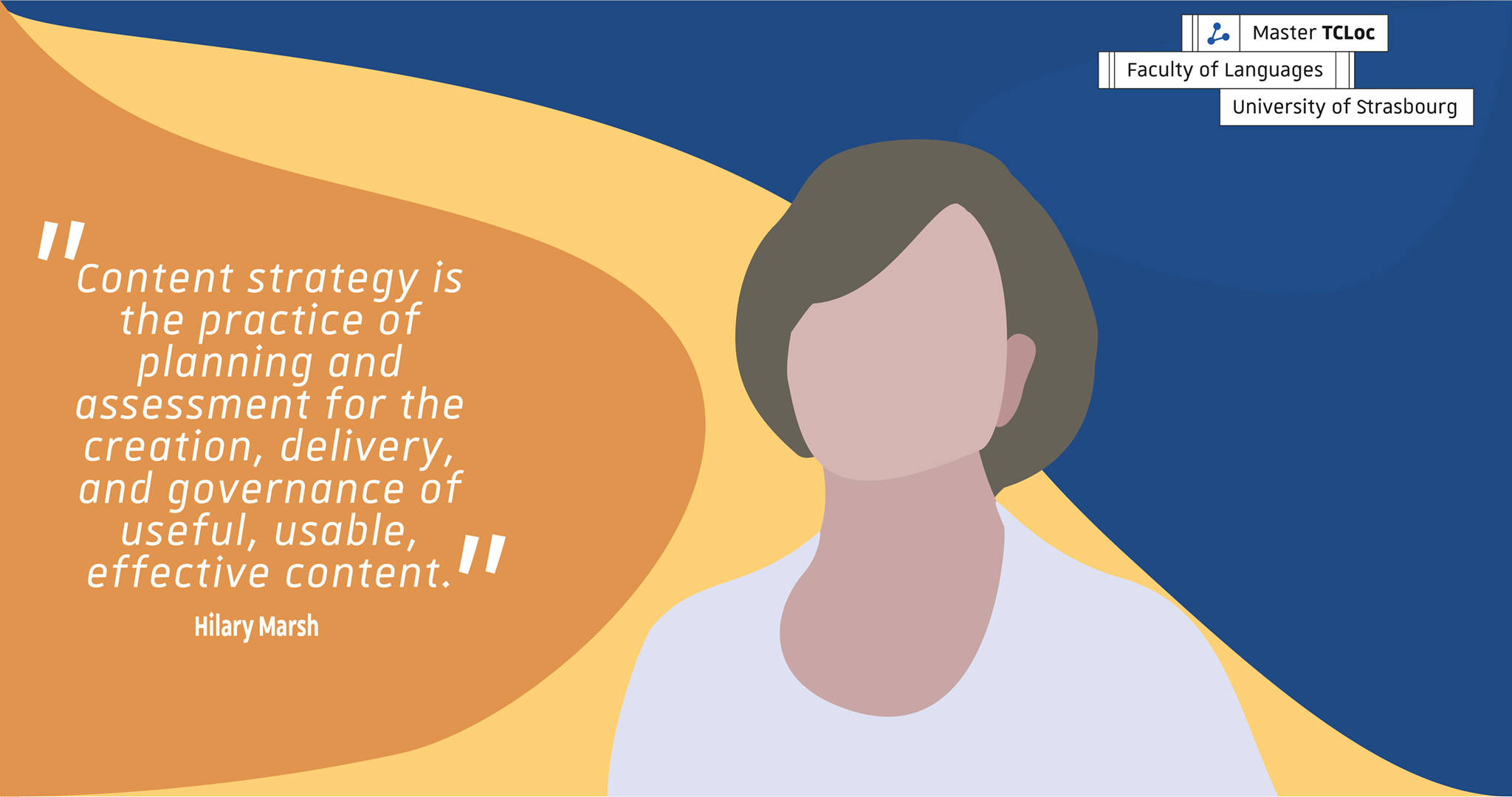Joining the TCLoc community of instructors is Hilary Marsh, a content strategist with decades of experience and president of Content Company, a content and digital strategy consultancy. She is a leading expert on effective and efficient content creation, organization, and management. Having already created and taught graduate-level courses on content strategy, she is excited to share her experience and insight with TCLoc students and show them the important role content strategy plays in technical communication. In this article, she gives us a sneak peek of her course and shares with us the professional path that led her to where she is now.
Discovering Content Strategy
We are so excited to have you as one of our instructors, Hilary. You have so much hands-on experience in the field. Did you know from the beginning that you wanted to help people create great content? How did you get your start?
My path to working with content started during my studies. I went to Syracuse University for psychology and magazine journalism. When I started at Syracuse, I was studying English. In my spare time, I helped edit the university’s literary magazine and learned, to my surprise, that the school offered a program in magazine journalism, so I transferred into that program. My professors stressed the importance of structuring articles with the most important points first, finding out the details behind the facts for a powerful story, and learning about the audience. I also studied psychology, which taught me about how people’s minds work. I find that I use both sets of skills in my work every day!
After graduating, I started my professional career as a magazine editor and then went on to be a copywriter for a large cosmetics company, where I wrote copy for both sales representatives and consumers. When I discovered the internet around 1995, I wanted to use my combined skills in editorial judgement and promotional/informational writing in this new medium. However, at the beginning, it was a struggle, because people assumed that websites were primarily about the cool technology and design, and content was an afterthought. (Unfortunately, this is still the case far too often even 25 years later!)
My first experience with writing digital content was for a nonprofit arts website. After that, I got a few assignments writing web copy for some corporate brand websites. I also wrote some magazine articles about websites’ business models. When I moved from New York City to Chicago in 1997, my previous work experience led me to a job for a major printing company, where I led the effort to revamp their corporate website, manage its content, and start their first intranet. In 1999, I took a position with an e-commerce beauty startup.
It sounds like, little by little, you got closer to what you wanted to do. Had you heard the term “content strategy” at this point, or was it still just a concept you had imagined?
I first heard the term “content strategy” at a conference in 1999, defined as applying a publishing mentality to a website, and I knew that that’s what I had been trying to invent. Several months later, I began working for Sapient, an interactive e-business consulting company, starting their content strategy practice in Chicago. I also taught a class in web content and information architecture for University of Chicago’s Graham School.
When the dot-com bubble burst in 2001, I was laid off, along with my whole team. Since I knew that every website needed a content strategy, I started a content strategy consultancy, Content Company, with my first client being a student from my course. I worked with that client, a large financial services firm, for several years, first helping them revamp their corporate site and then winning a large contract against major consulting firms to lead the content strategy for their first web-based intranet. I also started speaking at conferences about content management and content strategy, trying to help people make the connection between their business and their content.
It was a challenging time, because while content strategy was a known entity for the people and agencies that practiced it, most companies had no idea it existed or that they needed it!
It must have been difficult to convince companies that they needed something when they didn’t know it existed. Fortunately, you were helping spread the word—and still are today! What are some of your more recent projects?
In 2005, I started working for the National Association of Realtors (NAR), an association with more than 1 million members. I oversaw the organization’s member website and started its first social media program. My team and I worked with the organization’s staff to ensure that members understood what NAR offered to them and that could easily take advantage of its myriad programs, products, and services.
I left NAR in 2011 to restart my consultancy. I currently consult with associations, nonprofit organizations, government agencies, and corporations. In 2013, I developed and taught the first graduate-level content strategy course, for Kent State University. Over the years, I’ve spoken at numerous content strategy, UX, digital, and technology conferences in the United States, Germany, Denmark, and Australia. I also run mentoring groups for current or aspiring content strategists—the next one will start in January 2021.
Defining Content Strategy
Today, the idea of content strategy is not just accepted, it’s essential. But what does this term mean, exactly?
Content strategy, as I first learned it back in 1999, is identifying the who, what, where, and how of publishing content online. Since then, we’ve created deeper definitions, encompassing our understanding of everything needed to create a sustainable strategy for the organization’s content. The definition I use nowadays is this:
Content strategy is the practice of planning and assessment for the creation, delivery, and governance of useful, usable, effective content.
I added the word “effective” to the definition this year, because I wanted to make sure that organizations understand that content needs to have an explicit audience and clear, measurable goals.
It sounds like a thorough, inclusive definition. How can it be applied from different perspectives and to different contexts?
For the clients I work with, content represents their work—their programs, products, and services. Content strategy, then, is taking a strategic approach to the content OF and ABOUT their work. Kathy Wagner, of Content Strategy Inc. in Vancouver, Canada, calls the first type of content “core content,” distinguishing it from the marketing content about the work.
If you do an online search for “content strategy,” many of the results are actually about content marketing strategy. Content marketing strategy is about creating and then promoting content for marketing purposes, such as blog posts, customer stories or testimonials, and campaign-related content. Content marketing strategy uses many of the tactics and techniques of content strategy, but only for marketing-focused content.
The vast majority of valuable content that organizations create—the core content of their programs, products, and services—exists because the business exists. This includes content from the events they offer, information about the organization’s history, publications they produce, educational courses they offer, and so much more. This content doesn’t exist for marketing reasons at all and, without it, the organization would literally not exist and there would be nothing to market.
An example that’s especially relevant for technical writers is help content. The audience for help content is existing customers, and the goals are about increasing customer satisfaction and reducing support calls and complaints. These people were “leads” for marketers and became “users” of the website.
Considering the variety of content that exists, what is the most important thing to remember regarding content strategy?
Successful content is that which works for the audience and, therefore, the organization. A true organization-wide content strategy would make sure that the audience is at the center of all content decisions, whether it’s marketing content, product details, or support information. These decisions are about planning content; making sure it has the right voice and tone; stays updated; uses the organization’s taxonomy; and follows the criteria for promotion, maintenance, and retirement/expiration.
Making sure content is relevant to the audience is more complex when the audience may live in a variety of locations. Simple one-to-one translation of words is almost never enough to produce content that is relevant to audiences, so this has to be planned for from the beginning. The work involves creating internal lines of communication, establishing the right workflows, making sure the CMS templates accommodate multiple languages, and designing the pages to accommodate various requirements.
Teaching Content Strategy
As many of our students already work in fields related to technical communication and localization, they might already be aware of the importance of content strategy. How will this course help them understand it and use it in their professional lives?
This course is an introduction to the broad set of content strategy tools and techniques, with an emphasis on the core of audience understanding. It also covers topics that make content strategy especially challenging, such as planning content collaboratively, establishing success metrics, managing change, and getting senior-level buy-in. The course introduces these new concepts and practices and invites students to integrate and apply them to their own experiences and professional expertise.
By the end of the course, the students will be able to better facilitate content planning, improve content quality, and establish sustainable practices. While these skills are certainly applicable to translation and technical writing, they are also very relevant to those who work in project management and visual communication.
Content strategy is such an interesting topic and has so many applications. We’re proud to have you teaching it in our program. Thank you for your time and keep spreading the word about content strategy!
What did you think of this article? Do you use content strategy or do you see the need for it in your current job? Let us know in the comments below! If you’re interested in this course, check out the rest of the curriculum on the TCLoc website. And don’t forget to check out other articles on our blog!



